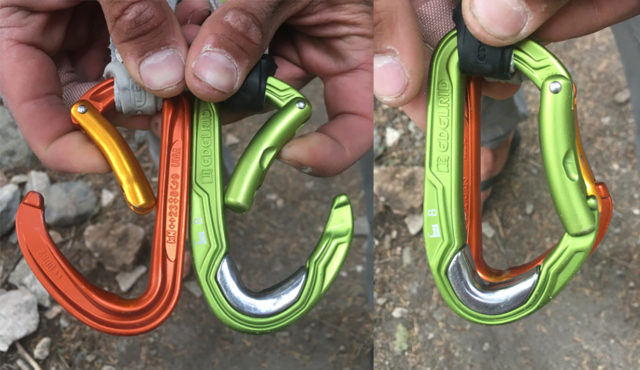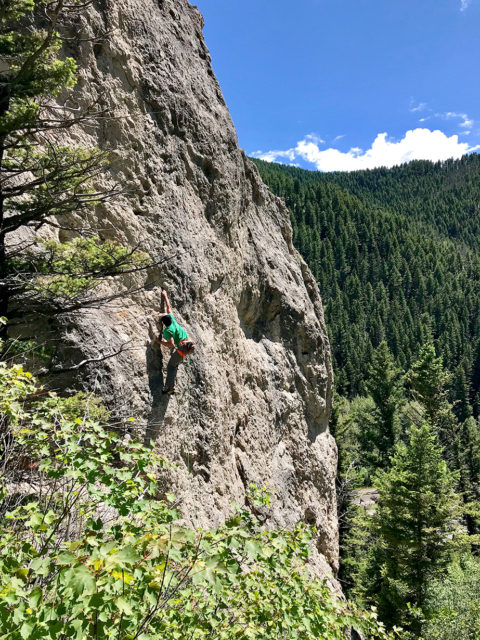
Edelrid Bulletproof Quickdraw
Carabiner Material:
- Bolt Carabiner: aluminum
- Rope Carabiner: aluminum w/ steel insert
Stated Weight (12 cm): 117 g
Blister’s Measured Weight (12 cm): 120 g
Closed Major Axis Strength: 24 kN
Open Major Axis Strength: 8 kN
Minor Axis Strength: 8 kN
Gate Type:
- Bolt Carabiner: straight
- Rope Carabiner: bent
Sling Material: nylon
Sling Width: 15-22 mm (tapered)
Available Sling Lengths: 12 cm, 18 cm
Closure: Keylock
MSRP:
- 12 cm: $28.95
- 18 cm: $29.95
Test Locations: Bozeman Area, MT
Days Tested: 25
Intro
While sport climbing isn’t very gear intensive compared to pursuits like alpine climbing, projecting, repeated falls, and multiple laps on climbs still tend to wear out specific pieces of gear at a very high rate. This is particularly true for quickdraws due to the repeated cycles of running a weighted rope across the relatively small radius of a single carabiner.
To extend the life of gear while still maintaining a reasonable weight and cost, Edelrid developed the Bulletproof series of carabiners, which feature a steel insert on the basket of an aluminum carabiner to increase the longevity of the loaded surface. After seeing aluminum carabiners wear out in single seasons or less, I was interested to see just how much of a difference the steel insert made in the lifespan of the Bulletproof quickdraw. So how’d they do?
Design
Carabiner and quickdraw technology is at a point where the differences between options on the market are often small and preferential, not groundbreaking. And apart from the steel insert, the Bulletproof draw looks just like most other quickdraws on the market. Both the bolt- and the rope-end carabiners on the Bulletproof are solid-gate, keylock nose, non-locking carabiners. The Bulletproof is available in both a 12cm and 18cm version, and the dogbone can be swapped out to user preference.
Carabiner Shape
The shape and “action” of quickdraws / carabiners are often where user preference often comes into play. Different carabiners often have subtle differences in the shape of the spine and gate, whether they use a solid or wire gate, and how snappy or smooth the gate closure is.
When compared to the Petzl Spirit draws (my current favorite sport draws), the carabiners on the Bulletproof draw are slightly more elongated and have slightly less curve to the gate on the rope-end carabiner. I personally prefer the slightly wider and rounder Spirit carabiners more as I find them easier to clip, but these differences are subtle and certainly up to personal preference.

The gate action on the Bulletproof carabiners is comparable to the Spirits though — nice and snappy with what I’d call a “medium” amount of tension. I think the Bulletproof carabiners have more tension than the CAMP Photon carabiner, but less than the Black Diamond Hotwire.
Weight
The Bulletproof quickdraw is a bit heavier than most regular aluminum solid-gate draws, but it’s still far lighter than full steel draws. For reference, below are some stated weights for a few notable solid-gate quickdraws. All except the two Edelrid draws use fully aluminum carabiners.
100 g Petzl Spirit Express Quickdraw, 17 cm
108 g DMM Alpha VW Sport Quickdraw, 18 cm
110 g Black Diamond Positron Quickdraw, 18 cm
113 g Petzl Djinn Axess Quickdraw, 17 cm
122 g Edelrid Bulletproof Quickdraw, 18 cm
302 g Edelrid Jim Steel Wire Quickdraw, 18 cm
Durability
This is the real issue in question. The Bulletproof quickdraws are anywhere from $10-$15 more expensive per quickdraw than “normal” aluminum quickdraws. So does the steel insert provide enough of an increase in durability to justify the increase in price?
In my experience, absolutely yes.

After a full season of climbing on the Bulletproof draws, I cannot discern any wear to the steel rope-bearing surface of the carabiner. Even when compared to burliest aluminum carabiners I’ve used, there’s no question that the Bulletproof’s steel insert withstands rope wear significantly better. I’ve seen aluminum carabiners develop a sharp edge after only a few days on a project, especially in areas with highly abrasive rock or lots of grit, and the fact that the Bulletproof draw has yet to show any wear is amazing.
From my experience, the Bulletproof draw seems to provide the same level of durability as a full steel carabiner (like those found on many perma-draws) at a significantly lower price and a fraction of the weight.
Who’s It For?
While I wouldn’t carry a full rack of Bulletproof draws up a route to put on every hanger, I think judiciously using a few on a sport route is an excellent way to prolong the life of your gear and take advantage of the Bulletproof’s increased durability while still keeping the cost of climbing reasonable.
For example, three places in particular on a sport route tend to receive the most wear: (1) the first draw on a route, (2) the draw directly below the crux, and (3) the anchor draw(s). These are the three places where I would most likely place the Bulletproof draw. I will still often use a standard quickdraw on other areas of the route as the amount of wear is significantly lower.
Bottom Line
I think the Edelrid Bulletproof carabiner concept is an elegant solution to increasing the durability of carabiners while still keeping weight and cost at a reasonable level. They are significantly more expensive than standard draws, but the Bulletproof quickdraws do not wear nearly as fast and they’re still pretty light. If you consistently sport climb outside (no matter how hard you climb), I would absolutely recommend adding a couple Bulletproof quickdraws to your rack.
